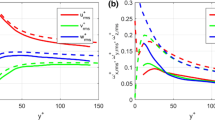Abstract
Particle tracking velocimetry (PTV) produces high-quality temporal information that is often neglected when computing spatial gradients. A method is presented here to utilize this temporal information in order to improve the estimation of spatial gradients for spatially unstructured Lagrangian data sets. Starting with an initial guess, this method penalizes any gradient estimate where the substantial derivative of vorticity along a pathline is not equal to the local vortex stretching/tilting. Furthermore, given an initial guess, this method can proceed on an individual pathline without any further reference to neighbouring pathlines. The equivalence of the substantial derivative and vortex stretching/tilting is based on the vorticity transport equation, where viscous diffusion is neglected. By minimizing the residual of the vorticity-transport equation, the proposed method is first tested to reduce error and noise on a synthetic Taylor–Green vortex field dissipating in time. Furthermore, when the proposed method is applied to high-density experimental data collected with ‘Shake-the-Box’ PTV, noise within the spatial gradients is significantly reduced. In the particular test case investigated here of an accelerating circular plate captured during a single run, the method acts to delineate the shear layer and vortex core, as well as resolve the Kelvin-Helmholtz instabilities, which were previously unidentifiable without the use of ensemble averaging. The proposed method shows promise for improving PTV measurements that require robust spatial gradients while retaining the unstructured Lagrangian perspective.











Similar content being viewed by others
References
Brachet ME, Meiron DI, Orszag SA, Nickel BG, Morf RH, Frisch U (1983) Small-scale structure of the TaylorGreen vortex. J Fluid Mech 130:411–452
Brunton SL, Rowley CW (2010) Fast computation of FTLE fields for unsteady flows: a comparison of methods. Chaos 20:1–12
Bunin GA, François G, Bonvin D (2013) From discrete measurements to bounded gradient estimates: a look at some regularizing structures. Ind Eng Chem Res 52(35):12500–12513
Canuto CG, Hussaini MY, Quarteroni AM, Zang TA (2007) Spectral methods: evolution to complex geometries and applications to fluid dynamics (scientific computation). Springer, New York
Correa CD, Hero R, Ma KL (2011) A comparison of gradient estimation methods for volume rendering on unstructured meshes. Vis Comput Graph IEEE Trans 17(3):305–319
Fernando JN, Rival DE (2016) Reynolds-number scaling of vortex pinch-off on low-aspect-ratio propulsors. J Fluid Mech 799. doi:10.1017/jfm.2016.396
Gesemann S, Huhn F, Schanz D, Schröder A (2016) From noisy particle tracks to velocity, acceleration and pressure fields using b-splines and penalties. In: 18th international symposium on applications of laser and imaging techniques to fluid mechanics, Lisbon, Portugal
Jeon YJ, Chatellier L, David L (2014) Fluid trajectory evaluation based on an ensemble-averaged cross-correlation in time-resolved piv. Exp Fluids 55:1766
Kaehler CJ, Scharnowski S, Cierpka C (2012) On the uncertainty of digital PIV and PTV near walls. Exp Fluids 52:1641–1656
Kim J, Moin P (1985) Application of a fractional-step method to incompressible Navier-Stokes equations. J Comput Phys 59(2):308–323
Meyer HTH, Eriksson M, Maggio RC (2001) Gradient estimation from irregularly spaced data sets. Math Geol 33(3):693–717
Neeteson NJ, Rival DE (2015) Pressure-field extraction on unstructured flow data using a voronoi tessellation-based networking alogrithm: a proof-of-principle study. Exp Fluids 56(44):44
Neeteson NJ, Bhattacharya S, Rival DE, Michaelis D, Schanz D, Schröder A (2016) Pressure-field extraction from lagrangian flow measurements: first experiences with 4d-ptv data. Exp Fluids 57:102
Orszag SA (1969) Numerical methods for the simulation of turbulence. Phys Fluids 12(12):2–250
Orszag SA (1971) On the elimination of aliasing in finite-difference schemes by filtering high-wavenumber components. J Atmos Sci 28(6):1074
Orszag SA (1972) Comparison of pseudospectral and spectral approximation. Stud Appl Math 51(3):253–259
Raben SG, Ross SD, Vlachos PP (2014) Computation of finite-time Lyapunov exponents from time resolved particle image velocimetry data. Exp Fluids 55(1638):1–14
Raffel M, Willert CE, Wereley ST, Kompenhans J (2007) Particle image velocimetry: a practical guide, 2nd edn. Springer, Berlin
Rockwood MP, Taira K, Green MA (2016) Detecting vortex formation and shedding in cylinder wakes using lagrangian coherent structures. AIAA J 55:15–23
Scarano F, Moore P (2012) An advection-based model to increase the temporal resolution of piv time series. Exp Fluids 52:919–933
Schanz D, Gesemann S, Schröder A (2016) Shake-the-box: Lagrangian particle tracking at high particle image densities. Exp Fluids 57:70
Schneiders J, Scarano F (2016) Dense velocity reconstruction from tomographic ptv with material derivatives. Exp Fluids 57:139
Schneiders J, Singh P, Scarano F (2016) Instantaneous flow reconstruction from particle trajectories with vortex-in-cell. In: 18th international symposium on the application of laser and imaging techniques to fluid mechanics, Lisbon, Portugal
Shadden SC, Dabiri JO, Marsden JE (2006) Lagrangian analysis of fluid transport in empirical vortex ring flows. Phys Fluids 18(047105):1–11
Taylor GI, Green AE (1937) Mechanism of the production of small eddies from large ones. Proc R Soc Lond Ser A Math Phys Sci 158(895):499–521
Wolf M, Holzner M, Krug D, Lüthi B, Kinzelbach W, Tsinober A (2013) Effects of mean shear on the local turbulent entrainment process. J Fluid Mech 731:95–116
Author information
Authors and Affiliations
Corresponding author
Electronic supplementary material
Below is the link to the electronic supplementary material.
Rights and permissions
About this article
Cite this article
Wong, J.G., Rosi, G.A., Rouhi, A. et al. Coupling temporal and spatial gradient information in high-density unstructured Lagrangian measurements. Exp Fluids 58, 140 (2017). https://doi.org/10.1007/s00348-017-2427-6
Received:
Revised:
Accepted:
Published:
DOI: https://doi.org/10.1007/s00348-017-2427-6




